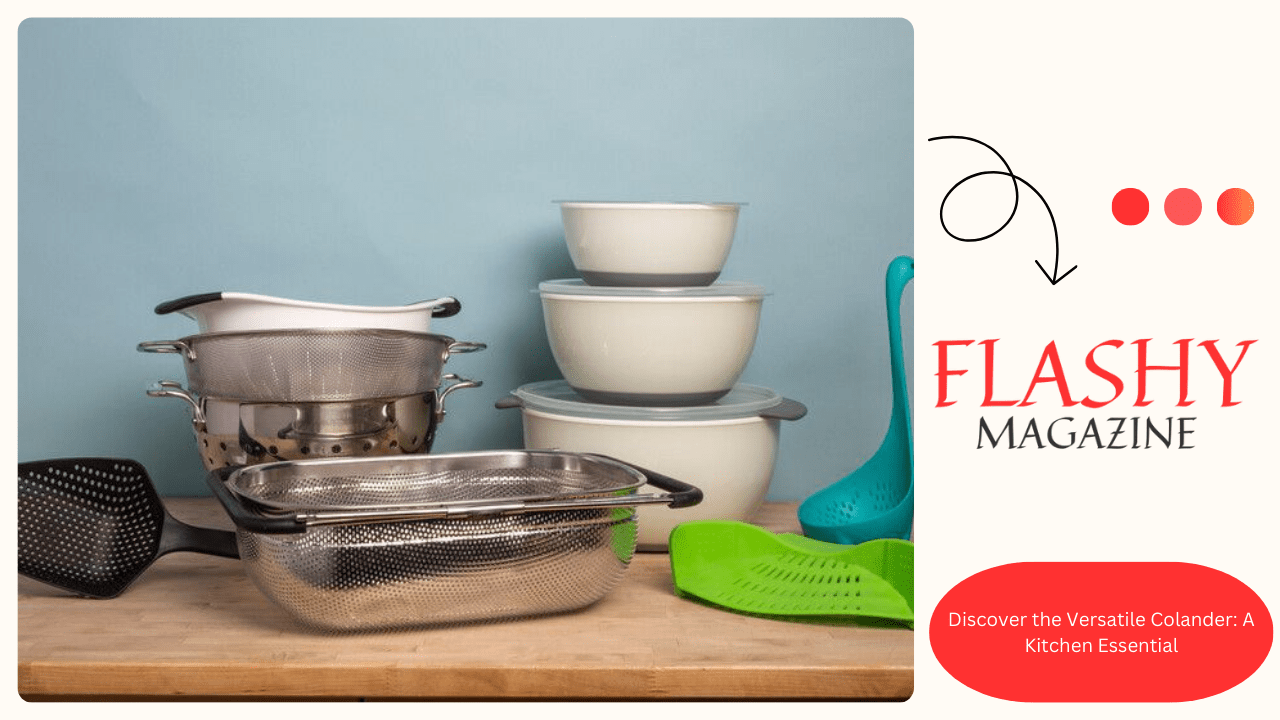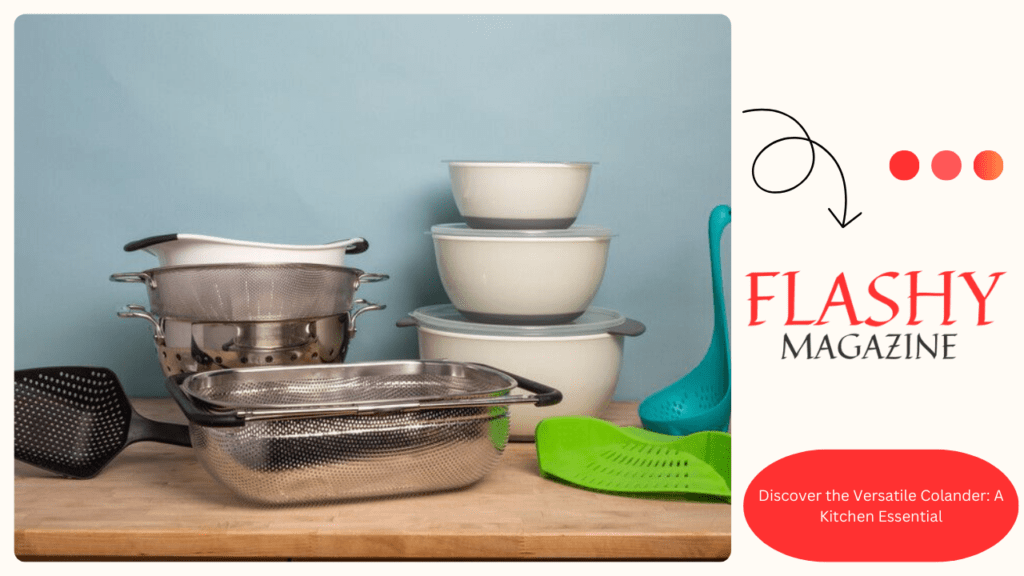A colander, also known as a colander or colander, is a kitchen chief that has helped culinarians around the world for centuries. This simple yet protean tool is essential for draining food liquids similar as pasta, irrigating vegetables, washing fruit, and indeed performing tasks in creative cuisine ways. Its perforated design allows liquids to pass through while retaining solid food, making it an necessary companion in kitchens of all sizes.
Preface to the Colander
A colander may feel like a simple tool, but it’s one of the most necessary particulars in any kitchen. Its perforated face and functional design make it a multi-purpose appliance, ideal for a wide range of kitchen tasks. Whether you are straining spaghetti, irrigating strawberries or sifting flour, a colander is your go- to tool. Let’s explore why this kitchen chief deserves a place in every home.
What’s a Colander?
Colanders are generally equipped with handles for easy running and occasionally a base for stability, colanders are made of accoutrements similar as essence, plastic or silicone. Their primary function is to separate food from liquid, but their uses go far beyond this introductory purpose.
The History and Development of the Colander
The colander dates back thousands of times, with early performances made from natural accoutrements similar as complexion or wood. Ancient societies used them to strain grains, separate whey from curds in rubbish timber, and wash yield. Over time, advances in metalworking enabled more durable colanders to be made from citation, bobby, and latterly pristine sword. moment, ultramodern colanders come in a variety of accoutrements , designs, and sizes to suit a variety of culinary requirements.
Types of Colanders
Colanders come in a variety of styles, each suitable for specific tasks. Most popular types:
Essence Colanders
These are generally made of pristine sword or aluminum and offer continuity and resistance to high temperatures. Essence colanders are ideal for draining hot liquids similar as boiling pasta water.
Plastic Colanders
Snipper snapper and affordable, plastic colanders are a popular choice for everyday use. They’re ideal for irrigating fruit and vegetables, but may not repel high temperatures as well as essence bones.
Collapsible Colanders
Collapsible colanders made of silicone are space- saving options for small kitchens. They can be smoothed for easy storehouse and are frequently dishwasher safe.
Colanders Above the Gomorrah
These colanders have extendable arms or a wide base that allows them to rest over the Gomorrah. This design is suitable for trickling a large quantum of food without taking up space on the counter.
Sieves Made of Fine Mesh
Although not technically a colander, a fine sieve serves analogous functions, similar as draining small pasta or sifting dry constituents similar as flour and icing sugar.
Accoutrements Used in the Construction of Colanders
The strainer material affects its lifetime, functionality and conservation conditions:
Stainless Sword
Stainless sword strainers are robust, erosion resistant and have a long service life. They’re the stylish choice for draining hot liquids and heavy foods.
Plastic
Plastic colanders are featherlight and affordable, available in a variety of colors and sizes.
Aluminum
Aluminum colanders are featherlight and durable, but bear regular care to help abrasion or erosion.
Crucial Features of a Good Colander
A high- quality colander should have the following characteristics:
- Continuity: Tough accoutrements that can handle hot liquids and frequent use.
- Stable Base: Wide or raised base to help tilting over.
- Comfortable Handles: Easy- grip handles for safe maneuvering.
- Unevenly Spaced Holes: Ensures quick and effective draining.
Common Uses of a Colander
Draining Pasta and Polls
Maybe the most iconic use of a colander, draining pasta, is a task no kitchen can avoid. A solid essence or plastic strainer ensures safe and effective draining.
Irrigating Vegetables and Fruits
The colander is ideal for washing products, as the perforations allow free inflow of water and insure thorough cleaning.
Discharge of Barrels
Fluently wash and drain canned sap, sludge, or other constituents to remove redundant sodium or saccharinity.
Creative Use for a Colander
Stew Sifting of Dry Constituents
The fine sieve also doubles as a sieve for incinerating constituents similar as flour or cocoa greasepaint.
DIY Systems and Decorations
Turn old colanders into ornamental lampshades, hanging flower pots or indeed storehouse baskets for small particulars.
Colander in Different Societies
Colanders have unique uses in different societies, similar as straining rice in Asian cookery or sifting grains in African cookery. Their versatility makes them a universal tool.
How to Choose the Right Colander for the Kitchen
Consider the following factors when choosing a colander:
- Size: Choose the size that suits your cuisine habits.
- Material: Choose pristine sword for continuity or silicone for compact storehouse.
- Purpose: Acclimatize the strainer type to your most common kitchen tasks.
How to Duly Clean and Maintain a Colander
- Essence Colanders: Wash with adulatory water and dry completely to help erosion.
- Plastic Colanders: Use a soft sponger to help scratching and wash incontinently after use.
- Silicone Colanders: Dishwasher safe and easy to clean with minimum trouble.
Safety Tips for Using a Colander
- Always wear gloves when draining hot liquids to avoid becks.
- Place the strainer on a stable face to help it from tilting over.
- Allow boiling water to cool slightly before draining to reduce splashing.
Colanders and Sustainability
Applicable colanders contribute to green cuisine by reducing the need for disposable particulars similar as paper napkins or disposable strainers.
Top Brands and Recommended Products
Brands like OXO, Cuisinart and KitchenAid offer dependable colanders in a variety of accoutrements and designs. Look for models with strong client reviews for continuity and performance.
Colander in Popular Culture
The colander has indeed set up a quirky place in pop culture, appearing in pictures, television shows, and as a symbol in” The Church of the Flight Spaghetti Monster,” where it’s humorously worn as a chapeau.
Comparison of Colanders with Analogous Kitchen Tools
While analogous tools similar as sieves and colanders partake lapping functions, colanders are best suited for larger quantities of food due to their capacity and design.
Budget vs. Upper Colanders
Introductory colanders start as low as$ 5, while high- end models with decoration accoutrements and features can bring$ 50 or further. Choose grounded on your cuisine needs and budget.
The Part of a Colander in a Ultramodern Kitchen
From cuisine pasta to preparing salads, colanders play a vital part in moment’s kitchens. Their versatility and practicality insure they remain an essential tool for home culinarians and professionals likewise.
Conclusion: Why Every Kitchen Needs a Colander
A colander may be simple, but its significance in the kitchen is inarguable. With innumerous uses and operations, it’s a tool that should not be missing in any ménage. From draining pasta to storming vegetables, the colander has proven itself time and time again and earned its place as a dateless kitchen essential.








